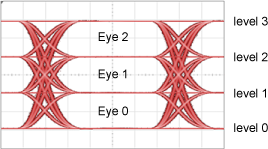:MEASure:PEYE:SERLimit?
Command Syntax
:MEASure:PEYE:SERLimit
Query Syntax
:MEASure:PEYE:SERLimit?
Description
For a PAM4 waveform, displays a SER limit measurement in the Eye table. If the measurement is already listed, the measurement is moved to the top of the table. To select the eye in the PAM4 eye diagram on which to return the measurement, use the :MEASURE:PEYE:SERLimit:EYE command. The measurement can be performed on one of three possible eyes as shown in the following picture: Eye 0/1, Eye 1/2, or Eye 2/3.
The query returns a string that reports whether the signal is limited by jitter, amplitude (noise and interference), or equally jitter and amplitude. SER limit indicates if the eye will close vertically before it closes horizontally or vice-versa. The SER limit is determined by extrapolating both the Jitter and Amplitude bathtub curves down to their respective SER floors. If the SER floors are within 10% (on a log scale) of each other, the system is considered balanced. If not, the limiting impairment is the one with the higher floor. If both SER floors are ≤ 1E-18, the SER limit cannot be determined and is listed in the Amplitude table as "Not Limited".
| Select | Command |
|---|---|
| Signal eye | :MEASure:PEYE:SERLimit:EYE
|

Amplitude analysis must be turned on before the first interference measurement can be made. Use the :MEASure:AMPLitude:DEFine:ANALysis command.
Measurement Identification
Avoid subtle programming errors! To ensure that the correct measurement is installed or queried, always explicitly identify a measurement when installing a measurement or querying a measured value, status, or detail. To identify a measurement, specify the measurement's source waveform (:SOURce child command). With some measurements, you may also need to specify other identifying values. Generally, when selecting a measurement using FlexDCA's GUI, if a dialog appears prompting you to select values, you should explicitly specify these values when remotely identifying the measurement. More information.
For example, to return the status of the measurement, :MEASure:PEYE:SERLimit?:
flex.write(':MEASure:PEYE:SERLimit?:SOURce CHAN1A')
if flex.query(':MEASure:PEYE:SERLimit?:STATus?') == 'CORR';
measurement = flex.query(':MEASure:PEYE:SERLimit??')
else:
details = flex.query(':MEASure:PEYE:SERLimit?:STATus:DETails?')
reason = flex.query(':MEASure:PEYE:SERLimit?:STATus:REASon?')
Child commands for measurement identification:
:MEASure:PEYE:SERLimit?:SOURce
Requires FlexDCA revision A.06.00 and above.
This command replaces deprecated command :AMPLitude:BERLimit.
Query Response
- AMPL
- Signal is limited by noise/interference.
- JITT
- Signal is limited by jitter.
- BAL
- Signal is limited by a balanced contribution of both jitter and noise/interference.
- NLIM
- The signal is not limited by jitter or noise/interference.
Example Command Sequence
:MEASure:PEYE:DEFine:ANALysis ON :MEASure:PEYE:SERLimit:SOURce CHAN1A :MEASure:PEYE:SERLimit :MEASure:PEYE:SERLimit?
Measurement Ready?
To confirm that the measurement is ready to read, you can query the measurement's status:
if ('CORR' in Flex.query(':MEASure:PEYE:SERLimit?:STATus?')):
measurement = Flex.query(':MEASure:PEYE:SERLimit??')
If averaging is turned on (:ACQuire:AVERaging), you can also confirm if the measurement result is ready by comparing the number of specified averages (:ACQuire:ECOunt?) versus the number of measurement sweeps that have occurred (:MEASure:PEYE:SERLimit?:COUNt?). The technique uses the :COUNt? common measurement query. For example,
if (Flex.query(':MEASure:PEYE:SERLimit?:COUNt?') >= Flex.query(':ACQuire:ECOUNt?')):
measurement = Flex.query(':MEASure:PEYE:SERLimit??')
You can also use an acquisition limit lest to test that a number of waveform samples, or pattern acquisitions have completed before returning a measurement. Refer to the :LTESt:ACQuire:CTYPe command.
Common Measurement Child Queries
This command supports the use of the following common measurement queries: :LOCation?, :COUNt?, :MAXimum?, :MINimum?, :MEAN?, and :SDEViation?.